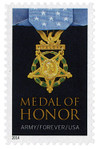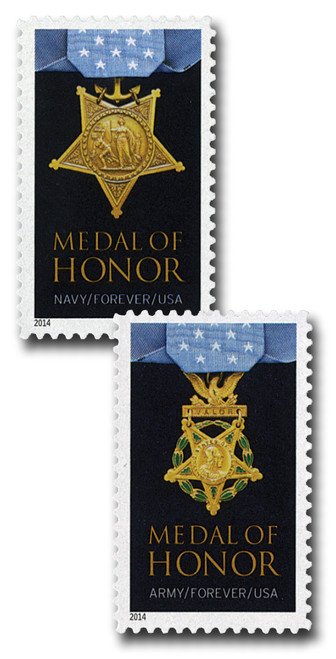
# 4823a - 2014 First-Class Forever Stamp - The Medal of Honor: Korean War - Army
U.S. # 4823a
2014 47¢: Army
Medal of Honor: Korean War
When his regiment was reactivated in 1951, WWII veteran Master Sergeant Woodrow W. Keeble (1917-82) volunteered his service in Korea. “Somebody has to teach these kids how to fight,” he said. His 24th Infantry Division soon found itself in central Korea about to take on the enemy in the mountainous region near Sangsan-ni. Known as Operation Nomad-Polar, the bloody battle to follow would rage on for six days in October 1951.
Keeble was injured on at least four occasions during the fight. Defying medics, he kept at the front with his men. The platoons were under heavy fire from three enemy positions and all of Keeble’s officers had fallen. By October 20th, the advance had been stopped by the barrage of bullets.
Alone and armed only with his rifle and grenades, Keeble crawled across the ground until he was close enough to a pillbox to strike. One by one, he took out each machine-gun emplacement, saving countless lives and allowing his men to advance and secure the position.
After the war, recommendations for a Medal of Honor fell through the cracks. “Woody” Keeble’s honor and heroism were finally recognized in 2008 with an Army Medal of Honor. He is the first full-blooded Sioux Indian to receive the award.
Following the format of the 2013 World War II Medal of Honor issue, the 2014 stamps honor the 145 recipients of the award from the Korean War. Photos of the last 13 living recipients were pictured on the front of the prestige folio, a new stamp format, with the names of all those rewarded printed in the back. The stamps picture the Army and Navy versions of the Medal of Honor, photographed by Richard Frasier.
Value: 47¢ 1-ounce first-class letter rate
Issued: July 26, 2014
First Day City: Washington, D.C. at the Arlington National Cemetery’s Amphitheater
Type of Stamp: Commemorative
Method: Offset printing in prestige folios of 20
Perforation: Serpentine Die Cut 11
Self-Adhesive
Quantity Printed: 30,000,000 stamps
The first stamp to feature the Medal of Honor (#2045) was issued in 1983. Beginning in 2013, the U.S.P.S. began issuing stamps honoring Medal of Honor Recipients from World War II (#4822-23), the Korean War (#4822a-23a), and the Vietnam War (#4988a).
Other U.S. issues honoring the Korean War include #2152 (Korean War Veterans), #3187e (from the Celebrate the Century pane), and #3803 (Korean War Veterans Memorial).
Battle Of Chipyong-Ni Begins

On February 13, 1951, the Battle of Chipyong-ni, sometimes called the “high-water mark” of the Chinese fighting in Korea, began.
Chinese forces first entered Korea in November 1950. UN troops were uncertain of their intentions or capabilities and drew back to the 38th parallel. When it became obvious that the Chinese had overstretched their supply lines, General Matthew B. Ridgeway decided to make a stand at Chipyong-ni, a key road intersection.
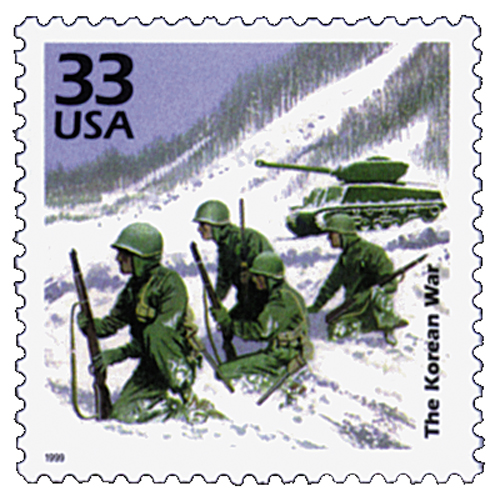
The 23rd Infantry Regiment arrived in advance of the People’s Volunteer Army (PVA) and dug defenses, prepared artillery, and set up communications. Three battalions, including one from France, reinforced them. General Paul Freeman, Jr, was in command of 4,500 men.
The Chinese first set up around Chipyong-ni during the afternoon of February 13, 1951, but all their attacks were held off. As General Paul Freeman predicted, the Chinese launched their attack that night. Between 10 pm and 7:30 am, the Chinese led multiple attacks on several French and American positions.
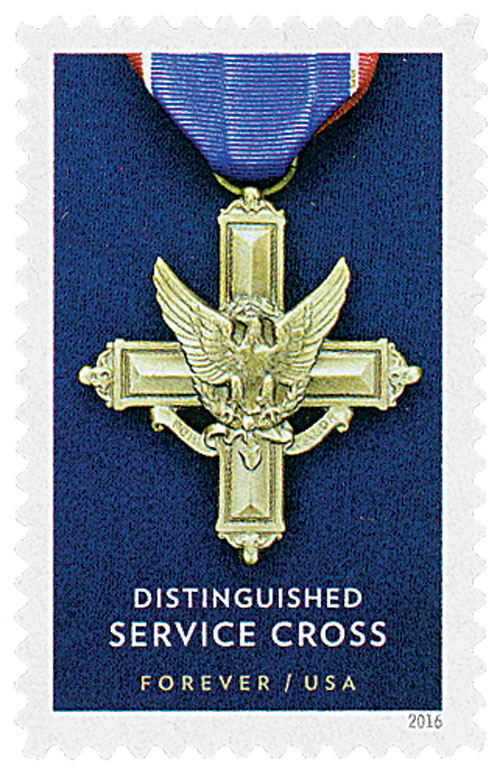
Though some of these attacks forced the Americans to move back from their positions, they eventually regained their ground with a minimal loss of life. General Freeman was wounded in the leg during that first night of fighting. He refused to be evacuated and insisted on remaining in Chipyong-ni until the battle was over. He was later awarded the Distinguished Service Cross for his bravery and leadership there.
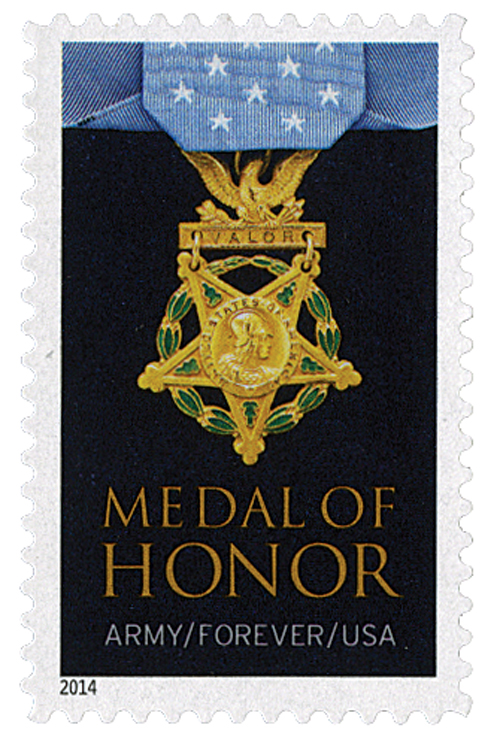
The Chinese called off their attacks on the morning of the 14th, as they knew the Air Force would soon be able to strike on them with ease. Fighting was minimal during the day but resumed again that night. The Americans were dangerously low on ammunition, so the Air Force began dropping it down along with flares, so the troops could find the much-needed supplies. The battle continued through the night and into the next afternoon. With the threat of Air Force napalm bombardment, the Chinese withdrew from battle. Chipyong-ni was a major morale booster for the Americans, who had previously seen the Chinese as unbeatable.
The Battle of Chipyong-ni proved to be a turning point in the war as the PVA began retreating north across the 38th Parallel. The battle has been called the “Gettysburg of the Korean War” and the high water mark of the Chinese involvement in the war.
U.S. # 4823a
2014 47¢: Army
Medal of Honor: Korean War
When his regiment was reactivated in 1951, WWII veteran Master Sergeant Woodrow W. Keeble (1917-82) volunteered his service in Korea. “Somebody has to teach these kids how to fight,” he said. His 24th Infantry Division soon found itself in central Korea about to take on the enemy in the mountainous region near Sangsan-ni. Known as Operation Nomad-Polar, the bloody battle to follow would rage on for six days in October 1951.
Keeble was injured on at least four occasions during the fight. Defying medics, he kept at the front with his men. The platoons were under heavy fire from three enemy positions and all of Keeble’s officers had fallen. By October 20th, the advance had been stopped by the barrage of bullets.
Alone and armed only with his rifle and grenades, Keeble crawled across the ground until he was close enough to a pillbox to strike. One by one, he took out each machine-gun emplacement, saving countless lives and allowing his men to advance and secure the position.
After the war, recommendations for a Medal of Honor fell through the cracks. “Woody” Keeble’s honor and heroism were finally recognized in 2008 with an Army Medal of Honor. He is the first full-blooded Sioux Indian to receive the award.
Following the format of the 2013 World War II Medal of Honor issue, the 2014 stamps honor the 145 recipients of the award from the Korean War. Photos of the last 13 living recipients were pictured on the front of the prestige folio, a new stamp format, with the names of all those rewarded printed in the back. The stamps picture the Army and Navy versions of the Medal of Honor, photographed by Richard Frasier.
Value: 47¢ 1-ounce first-class letter rate
Issued: July 26, 2014
First Day City: Washington, D.C. at the Arlington National Cemetery’s Amphitheater
Type of Stamp: Commemorative
Method: Offset printing in prestige folios of 20
Perforation: Serpentine Die Cut 11
Self-Adhesive
Quantity Printed: 30,000,000 stamps
The first stamp to feature the Medal of Honor (#2045) was issued in 1983. Beginning in 2013, the U.S.P.S. began issuing stamps honoring Medal of Honor Recipients from World War II (#4822-23), the Korean War (#4822a-23a), and the Vietnam War (#4988a).
Other U.S. issues honoring the Korean War include #2152 (Korean War Veterans), #3187e (from the Celebrate the Century pane), and #3803 (Korean War Veterans Memorial).
Battle Of Chipyong-Ni Begins

On February 13, 1951, the Battle of Chipyong-ni, sometimes called the “high-water mark” of the Chinese fighting in Korea, began.
Chinese forces first entered Korea in November 1950. UN troops were uncertain of their intentions or capabilities and drew back to the 38th parallel. When it became obvious that the Chinese had overstretched their supply lines, General Matthew B. Ridgeway decided to make a stand at Chipyong-ni, a key road intersection.

The 23rd Infantry Regiment arrived in advance of the People’s Volunteer Army (PVA) and dug defenses, prepared artillery, and set up communications. Three battalions, including one from France, reinforced them. General Paul Freeman, Jr, was in command of 4,500 men.
The Chinese first set up around Chipyong-ni during the afternoon of February 13, 1951, but all their attacks were held off. As General Paul Freeman predicted, the Chinese launched their attack that night. Between 10 pm and 7:30 am, the Chinese led multiple attacks on several French and American positions.

Though some of these attacks forced the Americans to move back from their positions, they eventually regained their ground with a minimal loss of life. General Freeman was wounded in the leg during that first night of fighting. He refused to be evacuated and insisted on remaining in Chipyong-ni until the battle was over. He was later awarded the Distinguished Service Cross for his bravery and leadership there.

The Chinese called off their attacks on the morning of the 14th, as they knew the Air Force would soon be able to strike on them with ease. Fighting was minimal during the day but resumed again that night. The Americans were dangerously low on ammunition, so the Air Force began dropping it down along with flares, so the troops could find the much-needed supplies. The battle continued through the night and into the next afternoon. With the threat of Air Force napalm bombardment, the Chinese withdrew from battle. Chipyong-ni was a major morale booster for the Americans, who had previously seen the Chinese as unbeatable.
The Battle of Chipyong-ni proved to be a turning point in the war as the PVA began retreating north across the 38th Parallel. The battle has been called the “Gettysburg of the Korean War” and the high water mark of the Chinese involvement in the war.



